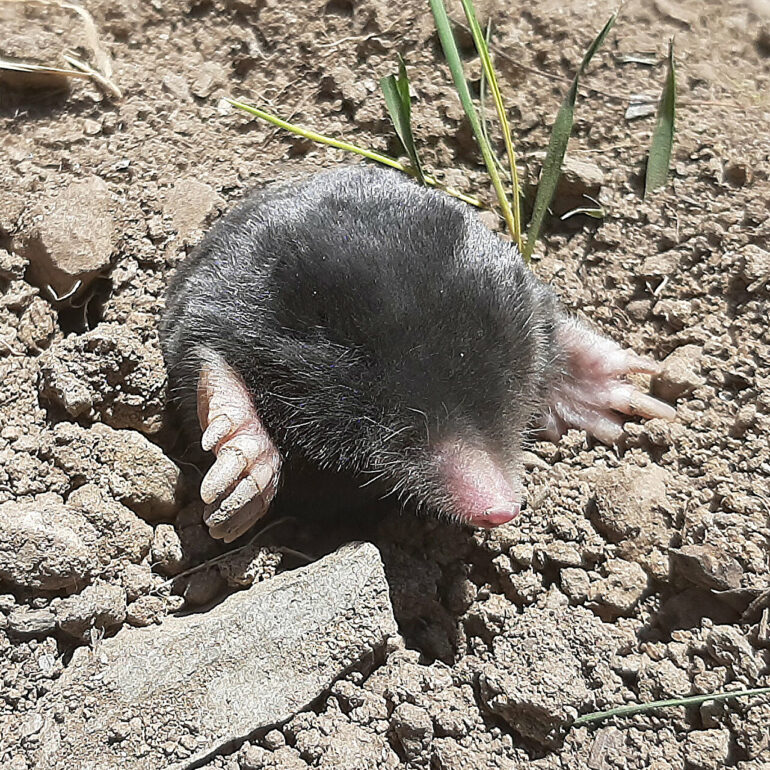Scientists have identified two types of mole which they believe have been living undiscovered in the mountains of eastern Turkey for as many as 3 million years.
The new moles—named Talpa hakkariensis and Talpa davidiana tatvanensis—belong to a familiar group of subterranean, invertebrate-eating mammals found across Europe and Western Asia.
While only one species, Talpa europaea, is found in Britain, further east there are a number of different moles, many of which have very small geographical ranges.
The researchers—using cutting edge DNA technology—have confirmed the new forms are biologically distinct from others in the group.
Both inhabit mountainous regions in eastern Turkey, and are able to survive in temperatures of up to 50°C in summer and being buried under two meters of snow in winter.
The study, published in the Zoological Journal of the Linnean Society, was conducted by researchers from Ondokuz Mayıs University (Turkey), Indiana University (U.S.), and the University of Plymouth (UK).
Senior author David Bilton, Professor of Aquatic Biology at the University of Plymouth, has previously been responsible for identifying almost 80 new species of animals, particularly insects, and said the new discoveries were notable for a number of reasons.
“It is very rare to find new species of mammals today,” he said. “There are only around 6,500 mammal species that have been identified across the world and, by comparison, there are around 400,000 species of beetles known, with an estimated 1–2 million on Earth.”
“Superficially, the new moles we have identified in this study appear similar to other species, since living underground imposes serious constraints on the evolution of body size and shape—there are a limited number of options available for moles really. Our study highlights how, in such circumstances, we can under-estimate the true nature of biodiversity, even in groups like mammals, where most people would assume we know all the species with which we share the planet.”
The discoveries mean that the number of known Eurasian moles has been raised from 16 to 18, and each have their own distinct genetic and physical characteristics.
To identify their latest finds, the researchers studied the size and shape of various bodily structures, using advanced mathematical analyses, which also allowed them to include specimens collected in the 19th century that are still available in museum collections.
A complimentary analysis of the moles’ DNA, and a detailed comparison with known species, then confirmed their distinctiveness.
As a result, Talpa hakkariensis—found in the Hakkari region of southeastern Turkey—was identified as a new species of mole, highly distinctive in terms of both its morphology and DNA.
Talpa davidiana tatvanensis—found near Bitlis, also in southeastern Turkey—was also identified as being morphologically distinct but has been classified as a subspecies of Talpa davidiana. First identified in 1884, T. davidiana it is listed as data deficient by the International Union for Conservation of Nature (IUCN).
Professor Bilton added, “We have no doubt that further investigations will reveal additional diversity, and that more new species of mole remain undiscovered in this and adjacent regions. Amid increasing calls to preserve global biodiversity, if we are looking to protect species we need to know they exist in the first place. Through this study, we have established something of a hidden pocket of biodiversity and know far more about the species that live within it than previously. That will be critical for conservation experts, and society as a whole, when considering how best to manage this part of the planet.”
More information:
İslam Gündüz et al, Notes from the Anatolian underground: two new mole taxa from Eastern Turkey, together with a revised phylogeny of the genus Talpa (Mammalia: Eulipotyphla: Talpidae), Zoological Journal of the Linnean Society (2023). DOI: 10.1093/zoolinnean/zlad049
Provided by
University of Plymouth
Citation:
Scientists identify two new species of mole in the mountains of eastern Turkey (2023, August 11)



